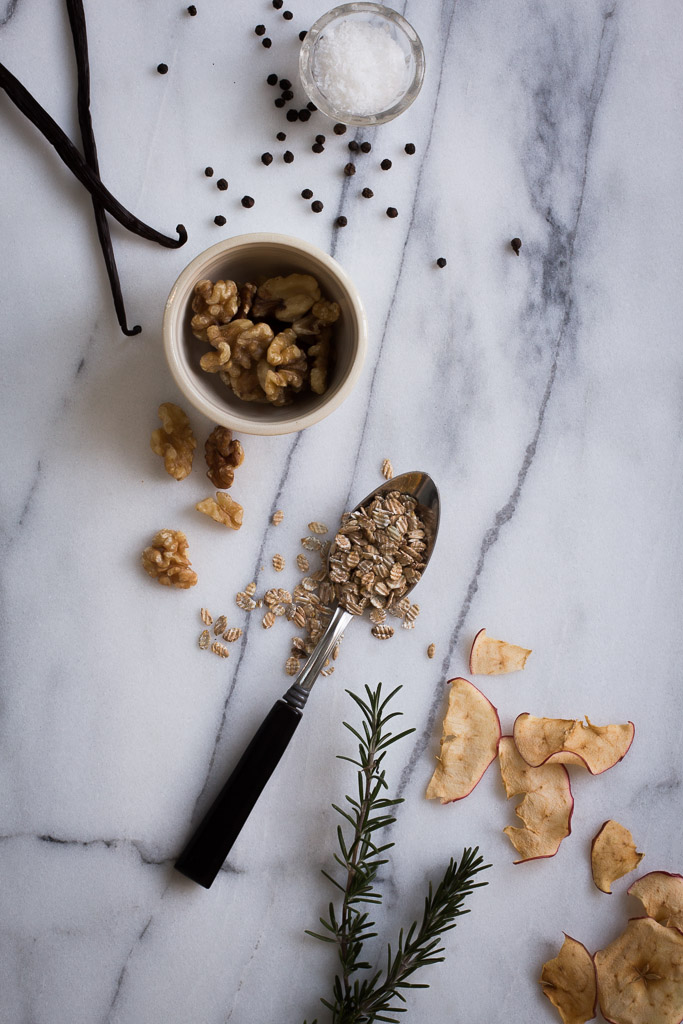I am not really a believer in New Year’s resolutions. They always seem to putter out somewhere around March. I prefer to secret away an afternoon in the quiet, darkening days of January to imagine what I want from the year. I prefer to head out into the new year with a roadmap and an intention. Though I don’t always end up at my original destination, things always seem to fall into place somehow.
This year, I find myself thinking about how to clear away the extraneous, the white noise. Too much television. Worrying about what other people think. Falling down the Internet’s many rabbit holes. Sweeping away the distractions helps reveal the essential. Family. Friendship. Creativity. Beauty. Nature. Those things that sustain me.
The idea of sustenance has been on my mind a lot lately. Busy-ness has a way of taking over, like a creeping vine, if you forget to prune it back. So as I plan out each week, I schedule in time to write and take photos and go for walks, activities that sustain my spirit and keep the busy-ness in check.
In the kitchen too, I’ve been thinking about sustenance. As someone who earns her livelihood through food, it’s not always easy to navigate the territory between flavor and health. I learned to cook in restaurant kitchens, where butter and cream and sugar and salt are the go-to shortcuts to flavor. And let’s be honest--butter, cream, sugar and salt are glorious in the kitchen, adding roundness and coaxing forth layers of deliciousness from other, more subtle, ingredients. I am most certainly not among those who vilify fat or carbohydrates or any food at all for that matter.
But I do know that too much of a good thing can be, well, too much. I just returned from a trip to San Francisco with my mother. We did all the fun, mother-daughter things one should do on a trip to San Francisco. We rode a ferry to Alcatraz Island and snapped pictures of the Bay Bridge and the city skyline with the sun glinting off the water. We explored Golden Gate Park and spent an afternoon entranced by the underwater dreamscape at the California Academy of Sciences aquarium. We wandered the streets of the city and stumbled upon lovely handmade jewelry and gorgeous earth-toned ceramics and a hidden trove of vintage kitchen wares.
And we ate.
We waited in the ever-present line at Tartine for flaky croissants and light-as-air meringues. We ate tacos from a bodega in the Mission. We had some of the best pasta I’ve ever had--housemade ditalini with dungeness crab and uni butter--at Locanda. We brunched on lentil fritters with a silky beet sauce, kefir and cilantro oil at Bar Tartine. At Range, my favorite restaurant in the Bay Area, I had crisp-skinned roasted chicken with a bread salad of chicory, dates, bacon and fresh herbs. We finished the trip at 20th Century Cafe (a gem of a place) with golden pierogi served with damson plum preserves, lighter-than-air apple strudel and a slice of Russian honey cake. Each meal was a treasure.
I wouldn’t change a thing about our trip. But when I got home, I was decidedly done with buttery pastries and creamy sauces. I craved fresher, lighter meals. Greens and whole grains and brothy soups. The sort of food that leaves you ready to dive into your day rather than in a food coma and in need of a nap.
This posole verde is one of the recipes I turn to at times like this. I first made this soup last summer with tomatillos from the farmers market. But I was craving it this winter and discovered that it works beautifully with canned tomatillos as well.
In addition to the tart tomatillos, this posole has earthy hominy to give it body and texture. There are jalapeños to liven things up and cooling cilantro to balance the kick of the chiles. The chicken makes this soup a filling meal, but pintos or black beans would work just as well if you prefer to keep it vegetarian. And of course, you can’t leave off the toppings. For me, posole is all about the bright, crunchy toppings added to each bowl just before serving.
This posole brings a little summer warmth to January days and is just the kind of sustenance I’m looking for as I head towards spring with a roadmap for a fresh, new year in hand.
P.S. I'm always looking for inspiration, so I'd love to hear about your go-to fresh, healthy meals in the comments below!
I’m generally not a champion of the boneless, skinless chicken breast. Mostly because it isn’t as flavorful as other cuts of chicken and it’s more difficult to cook properly. But I like the delicate chicken flavor it brings to this light, fresh soup. The handling of the chicken is a bit fussier here due to the fact that breast meat is leaner and will get dry and tough it is not cooked gently. Feel free to substitute skinless chicken thighs, pork loin or tenderloin or even braised pork shoulder in place of the chicken breasts if you prefer.
Posole Verde (Tomatillo, Hominy and Chicken Soup)
- 1 recipe garnishes (see below)
- 1 medium yellow onion, diced
- 1 lb fresh tomatillos, diced or 1 28-oz can tomatillos, drained
- 3 cloves garlic
- 1 jalapeño (seeds optional), quartered
- Packed ⅓ cup cilantro (some stems are fine)
- 4 cups chicken or vegetable stock (preferably homemade), divided
- 1 bay leaf
- 4 cups cooked hominy (you can cook your own or use 1 28-oz. can)
- 2 large skinless chicken breasts (about 1 ¾ lbs)
Garnishes
1 large avocado, thinly sliced
1 lime cut into wedges
8-10 radishes, very thinly sliced
2 green onions, thinly sliced
1 ½ cups very finely shredded red or green cabbage
½ cup crema, sour cream or cotija cheese
Heat 1 cup of the stock in a medium saucepan. If you are using fresh tomatillos, add them to the pot along with the onion. If not, add only the onion. Simmer until the onion is tender, about 10 minutes. Set aside to cool slightly.
Working in batches, puree the onion and tomatillo (along with the cooking liquid), garlic, jalapeño and cilantro in a blender. Take care not to fill the blender more than ⅔ full so the hot mixture won’t force the lid off when you turn the blender on. That is not fun.
Transfer the pureed tomatillo mixture to a heavy-bottomed stockpot or Dutch oven. Add the rest of the stock, bay leaf, 1 ½ teaspoons salt and the hominy. Bring the soup to a simmer and add the chicken. Simmer, stirring occasionally, until the chicken is just cooked through, 15-20 minutes. You can check to see if the chicken is done by removing it and cutting into it with a paring knife. Take care not to overcook it as it gets dry and stringy. You want it to be completely opaque, without any traces of pink but still juicy. Remove the chicken from the pot and set it aside to cool. Continue to cook the soup at a bare simmer for another 10-15 minutes to allow the flavors to come together.
When the chicken is cool enough to handle but still warm, cut it into 1-inch cubes. Use your fingers to shred the cubed chicken. Do not return the chicken to the pot. Cooking the chicken in the soup further will cause it to lose moisture and toughen.
Taste the posole and add more salt if necessary. Remove the bay leaf. Ladle the hot soup into serving bowls. Spoon some of the shredded chicken into the center of each bowl. Serve very hot accompanied by garnishes.
*Note: If you don’t eat all of the posole, you can either cool the tomatillo-hominy base then add the shredded chicken and refrigerate, taking care not to overcook the chicken when you reheat the soup. Or you can store the tomatillo-hominy base and the chicken separately in the refrigerator. When reheating the soup, stir the chicken in just before serving and take it off the heat as soon as the chicken is heated through.


























